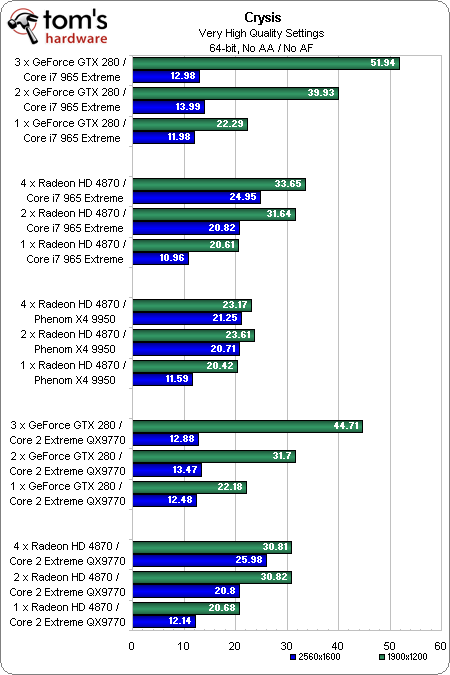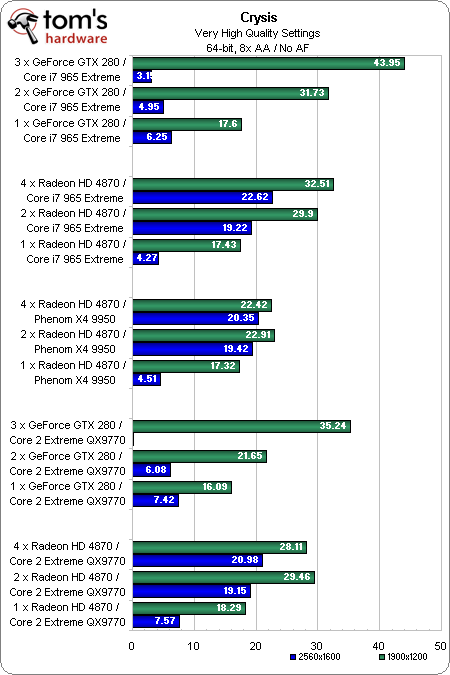Core i7: 4-Way CrossFire, 3-way SLI, Paradise?
Benchmark Results: Crysis 64-bit
We just had to try the 64-bit version of Crysis—and we’re yet again presented with mind-blowing results.

Let’s start this round off by talking about resolutions. Nvidia’s GeForce GTX 280 demonstrates beautiful scaling at 1900x1200 on both the Core 2 Extreme and Core i7 systems, with Core i7 showing off some impressive performance gains in what we thought would be a test dominated by the fastest graphics processor. Nevertheless, ratcheting up to two and three GTX 280s buys significant gains. But 2560x1600 is a different story entirely. In fact, we’d call the discrepancy between the two resolutions a full-blown disaster. One, two, three cards—it doesn’t matter. You’re looking at unplayable frame rates across the board.
Once again, Phenom X4 runs out of breath with a single Radeon HD 4870 at 1920x1200. Beyond that, you can’t expect much extra, even with a jump to four GPUs.
Core i7 965 Extreme and Core 2 Extreme QX9770 perform very similarly with Radeons under the hood. They actually both peter out and yield fairly poor scaling from two RV770s to four. And even at 1900x1200, we’d hesitate to call the performance of four GPUs playable. This doesn’t bode particularly well for the addition of anti-aliasing.

For the first time in our testing so far, we’re seeing ultra high-end platforms kicked to the floor.
We’ll take the resolution route again here. Nvidia’s GeForce GTX 280 again yields picture-perfect scaling at 1920x1200, even giving us the chance to enjoy quasi-playable frame rates with 3-way SLI cranking away. We also see a reason to get excited about Core i7. As Fedy pointed out in our Nehalem preview, Core i7 supports macro-ops fusion in 64-bit mode, so there’s a fair chance that we’re getting a performance boost from this enhancement given the sizable frame rate increase.
But then we shift to 2560x1600 and performance not only tanks—it actually gets worse as you add graphics cards. On the Core 2 Extreme, the benchmark fails entirely.
Get Tom's Hardware's best news and in-depth reviews, straight to your inbox.
AMD’s Radeon HD 4870s fare better across the board. Unfortunately, they’re never quite fast enough to serve up playable frame rates in this fast-paced first-person shooter. Perhaps the most interesting performance inflection is the single Radeon HD 4870—a 512 MB board. Given its memory handicap, frame rates linger in the single-digit range. The Radeon HD 4870 X2 adds a second GPU, but more important here is the shift to 1 GB of GDDR5 per processor, which multiplies performance by four.
Current page: Benchmark Results: Crysis 64-bit
Prev Page Benchmark Results: Supreme Commander: Forged Alliance Next Page Benchmark Results: Crysis: Warhead-
DFGum Yep, i hafta say being able to switch brands of graphics cards on a whim and selling off the old is great. Knowing im going to be getting the preformance these cards are capable of (better price to preformance ratio) is nice also.Reply -
cangelini randomizerSLI scales so nicely on X58.Reply
Hey you even got a "First" in there Randomizer! -
randomizer cangeliniHey you even got a "First" in there Randomizer!And modest old me didn't even mention it. :lol:Reply -
enewmen Still waiting for the 4870 X2s to be used in these bechmarks. I thought THG got a couple for the $4500 exteme system. But still happy to see articles like this so early!Reply -
cangelini enewmenStill waiting for the 4870 X2s to be used in these bechmarks. I thought THG got a couple for the $4500 exteme system. But still happy to see articles like this so early!Reply
Go check out the benchmark pages man! Every one with 1, 2, 4 4870s. The 2x and 4x configs are achieved with X2s, too.
Oh, and latest drivers all around, too. Crazy, I know! =) -
enewmen cangeliniI found it, just read the article too quickly. - My bad.Reply
"A single Radeon HD 4870 X2—representing our 2 x Radeon HD 4870 scores—is similarly capable of scaling fan speed on its own. "
Hope to see driver updates like you said. -
spyde Hi there, my question regarding these benchmarks with the HD card is, "was a 2G card use or a 1G". I am about to buy a new system and was looking to buy 2 x HD4870X2 2G cards, but with these results its looking a bit ify. I hope you can answer my question.Reply
Cheers. -
Proximon That's a nice article. I especially like the way the graphs are done. everything is scaled right, and you get an accurate representation.Reply
